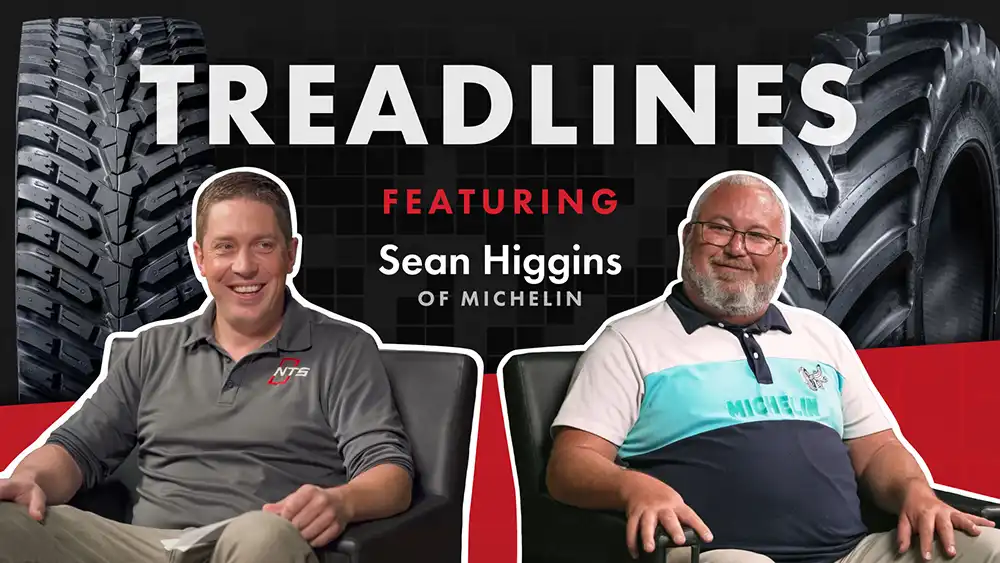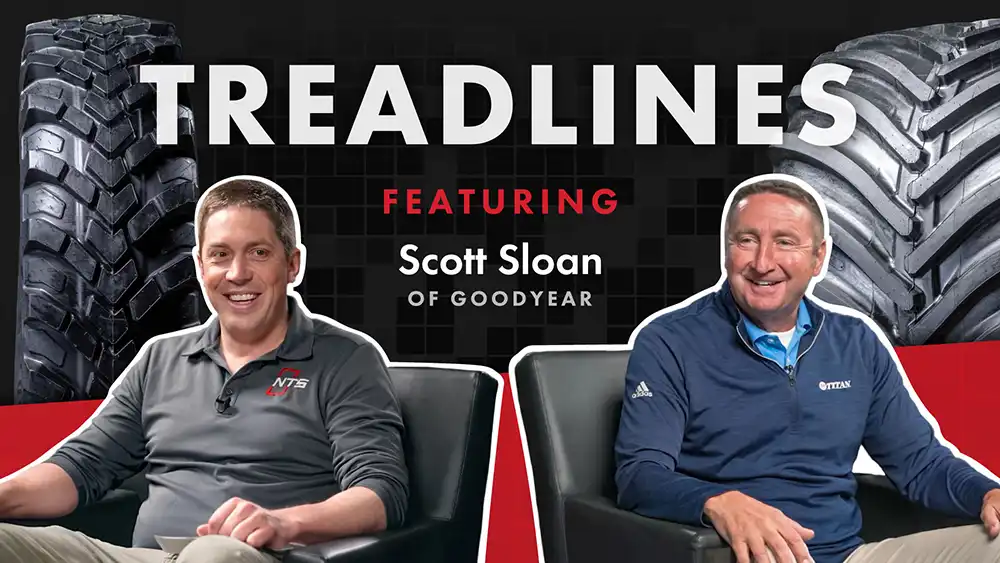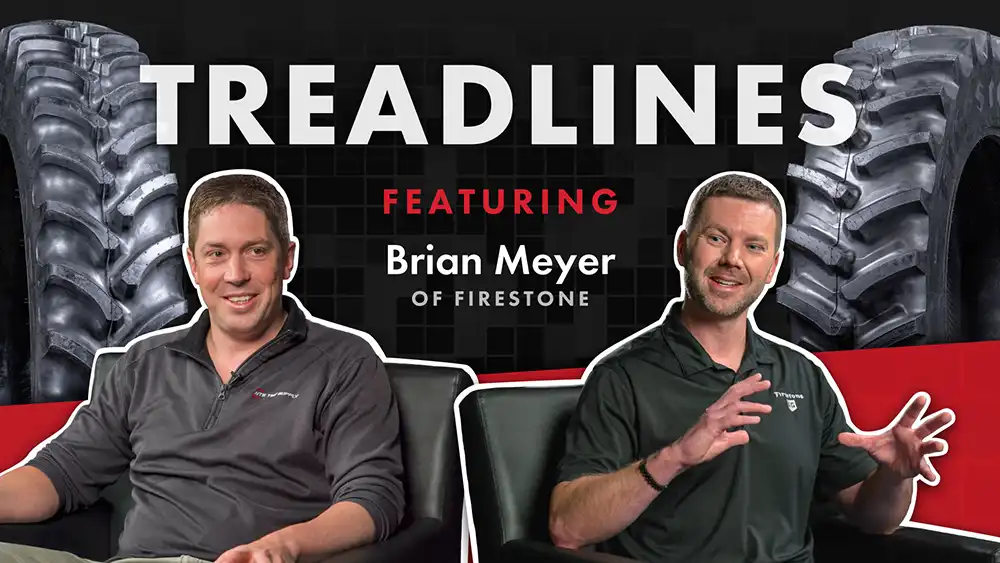In 2018 NTS Tire Supply sponsored a study to see if planting into the tracks of Goodyear LSW super singles would crush or protect yields. The answer? Yes, you can plant behind LSWs without losing yields. By the time data collection and field observations were complete, we came away with 5 takeaways, including one that surprised us: Even with these massive tires, lower air pressure is still critical for optimum yields.

Massive Tires with Big Benefits
If you’re not familiar with LSW super singles, the idea is pretty simple: one massively wide tire takes the place of a traditional dual setup. At NTS Tire Supply, we’ve been selling Goodyear LSWs since 2017. Customers who buy them tend to love them, especially for planting and combining. Farmer feedback has identified a few benefits of these massive tires:
- Better traction through wet spots.
- More secure machine handling in the field and down the road.
- Better fuel economy.
- Less rutting and compaction.
In other words, swapping traditional dual setups for LSWs can lower your fuel bill, provide better traction, and help your tractor float instead of climbing out of its own ruts all day.
You might like: Our insights into LSW performance for combines, fitment & FAQs.

Inside vs. Outside the Tire Track: The Effects of Planting Corn & Soybeans Behind LSWs
To determine the effects of planting with LSW super singles on both corn and soybeans, NTS Tire Supply partnered with Nate Firle, chief agronomist and owner of AgRevival Research in Gibbon, Minnesota, in 2018. Specifically, we were interested in comparing the plants growing outside the tractor’s tire tracks to those growing inside the tire tracks.
For this study, we compared two Goodyear LSW setups:
- 1100 Setup (New Holland): LSW1000/40R32s in the front and LSW1100/30R46s in the rear.
- 1400 Setup (John Deere): LSW1100/35R32s in the front and LSW1400/30R46s in the rear.
We observed the fields during the growing season to determine the LSWs’ impacts on soil compaction, plant and root development, final stand, and yield. One thing to note as you consider the test results is that the spring of 2018 was very wet.

5 Study Highlights: From Healthy Roots to Higher Yields
1. Final stands were almost identical inside and outside the tire tracks on corn & beans.
With corn, the final stand was virtually identical inside and outside the tire tracks.
With soybeans, in average field conditions, there was no reduction in the final stand between the two zones—inside and outside the tire tracks. In wet spots, we saw a 5% reduction in stand in very localized areas. Phytophthora was the main cause of stand reduction. (This disease causes soybean plants to die in-season in wet areas that have high-compaction and low oxygen levels.) We did see phytophthora impact areas outside the tire tracks, too. However, it was slightly less prevalent.
2. Plant and Root Development took a hit with the 1400 Setup.
Here we have to break the study down into the two tire setups we used—the 1100s and 1400s. In the areas planted by the tractor with the 1100s, there was no significant difference between soybeans inside and outside the tire tracks. With corn, plants growing outside the tire tracks showed a very slight advantage in root development.
With the 1400 setup, however, we saw some negative impacts on both corn and beans. There was a slight reduction in vegetative growth and root development under average conditions. In wet areas, the differences were more noticeable: The root systems were flatter and closer to the soil surface. Using a drone to survey the fields, we could see that the plants in the tire track areas were stunted and behind in maturity. Through the most waterlogged areas, the final stand was noticeably thinner.
3. #2 Shows How Critical Air Pressure is to Crop Development
What led to the poorer performance of the 1400 setup above? Air pressure. Our New Holland with the 1100 setup weighed 26,000 pounds and ran 8 psi in the front tires and 12 psi in the rear tires. Our Deere, on the other hand, tipped the scales at a hefty 60,000 pounds when 60% loaded with seed and fertilizer. It ran 13 psi in the front and 25 psi in the back—roughly double the air pressure of the 1100 setup.
When you’re forced to run at a higher air pressure, you decrease the tire’s footprint size and increase the pounds per square inch (PSI) on the soil. The end result is more soil compaction because the machine’s weight is distributed over a smaller area.
4. Super Singles Allow Healthy Root Development
Compaction squeezes root development on both corn and soybeans when it reaches 200 psi, as measured by a compaction meter inserted into the ground. For this study, we took compaction readings at 3, 6, and 9 inches, both inside and outside the tire tracks on our 1100 New Holland setup. Here is what we observed:

As you can see, the effects of the tire track narrowed as we measured deeper. At 9 inches into the soil, there was no practical difference between compaction levels inside and outside of the tire tracks. As we observed, healthy roots were able to develop inside the tracks of the 1100 LSW.
5. Strong Potential for Yield Increases with 1100 LSWs
With the 1100 LSW setup, we observed a uniform kernel count on corn and uniform plant development on soybeans inside and outside the tire tracks. Plus, the 1100s eliminated the pinch row effect, which will happen on the inside six rows when a planter’s lift tires follow behind the tractor duals. Given these facts, we predict that yield increases are possible when using an 1100 LSW setup versus duals.
Even with our heavier (and higher-air-pressure) 1400 LSW setup, we observed uniform corn kernel counts between ears from inside and outside the tire tracks. (However, the corn in the tire track had lighter, shallower kernels.) Because of the thinner stands with the 1400 setup, especially in the wettest areas, we would expect to see an overall yield drop for tire track areas.

Less Compaction = More Bushels & More Revenue
A 2016 study conducted by Titan International in Iowa, reached the same conclusion as the NTS study: planting into the tracks of 1100 LSWs has the potential to deliver more bushels per acre than planting with a traditional dual setup.
Read More: Results of Titan’s planting with LSWs study.
In the corn test plot, ground planted with a tractor wearing Goodyear LSW super singles yielded 5 bushels more per acre compared to ground planted with duals. In the study’s soybean plot, ground planted with the LSW tractor yielded 6 bushels more per acre compared to the dual setup. At the time, this resulted in a $16 per acre net revenue increase on corn, and a $60 per acre net revenue increase on soybeans. (These amounts would obviously fluctuate with commodity prices.)
With these test results, the farmer who performed the study believed that he could pay off his LSW super single upgrade in less than 1 year.
Goodyear LSW Super Single Models

Goodyear Optitrac
The Optitrac features Goodyear's latest generation of rubber compound and construction technology. Its lugs are shaped for improved traction, better stability, and a comfortable ride for roading. Deep tread helps with additional grip in the field and promotes longer tire life. Goodyear even boasts of the tire's "distinctive look and decoration," so there's style points for you too.
Available LSW Sizes:

Goodyear Custom Flo Grip
With deep, R-2 tread, the Flo Grip is especially welcome during wet years. However, the deep tread will help prolong the tire's life in any conditions. Increased lug bracing provides durability even under heavy loads.
Available LSW Sizes:

Goodyear DT930
Available right now only in the 1100/45R46 size, the DT930 features a lug angle that's optimized for both traction and cleanout in muddy conditions. As with Goodyear's other LSW models, the DT930 provides a comfortable ride and good flotation in the field.
Available LSW Sizes:
Are LSW super singles the answer to protect your soil?
If you’re considering an upgrade to LSW super singles, it’s important to talk to one of our tire experts to see if ditching duals on your planting setup is the right move. There’s a chance we’ll recommend that you stick with your duals—or even upgrade to different duals (maybe IF- or VF-rated tires) rather than travel down the LSW road.
Why? As we mentioned in the study highlights above, it all comes down to air pressure. Based on our research and experience, 1100 or 1400 LSWs will only benefit your operation if you can keep the air pressure below 15 PSI. If you have to go higher, based on the load you’re carrying/pulling, it’s probably better to stick with a dual or triple setup.
If you want to explore tire options for your planting tractor(s), give NTS Tire Supply a call and we’ll use our knowledge and experience to drive your farm forward.

.png)
.jpg)



















